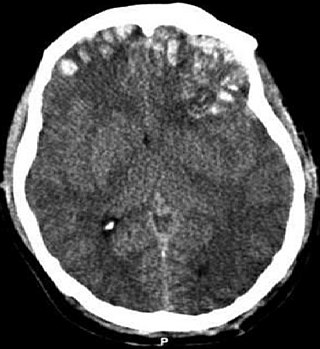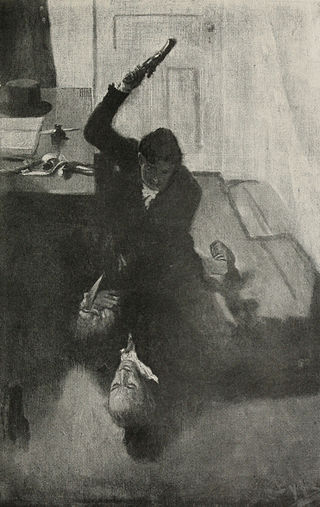Related Research Articles

Asphyxia or asphyxiation is a condition of deficient supply of oxygen to the body which arises from abnormal breathing. Asphyxia causes generalized hypoxia, which affects primarily the tissues and organs. There are many circumstances that can induce asphyxia, all of which are characterized by the inability of a person to acquire sufficient oxygen through breathing for an extended period of time. Asphyxia can cause coma or death.
Lust murder, also called sexual homicide, is a homicide which occurs in tandem with either an overt sexual assault or sexually symbolic behavior. Lust murder is associated with the paraphilic term erotophonophilia, which is sexual arousal or gratification contingent on the death of a human being. The term lust killing stems from the original work of Richard von Krafft-Ebing in his 1898 discussion of sadistic homicides. Commonly, this type of crime is manifested either by murder during sexual activity, by mutilating the sexual organs or areas of the victim's body, or by murder and mutilation. The mutilation of the victim may include evisceration, displacement of the sexual organs, or both. The mutilation usually takes place postmortem. Although the killing sequence may include an act of sexual intercourse, sexual intercourse does not always occur, and other types of sexual acts may be part of the homicide.

The post-mortem interval (PMI) is the time that has elapsed since an individual's death. When the time of death is not known, the interval may be estimated, and so an approximate time of death established. Postmortem interval estimations can range from hours, to days or even years depending on the type of evidence present. There are standard medical and scientific techniques supporting such an estimation.
Forensic medicine is a broad term used to describe a group of medical specialties which deal with the examination and diagnosis of individuals who have been injured by or who have died because of external or unnatural causes such as poisoning, assault, suicide and other forms of violence, and apply findings to law. Forensic medicine is a multi-disciplinary branch which includes the practice of forensic pathology, forensic psychiatry, forensic dentistry, forensic radiology and forensic toxicology. There are two main categories of forensic medicine; Clinical forensic medicine; Pathological forensics medicine, with the differing factor being the condition of the patients. In clinical forensic medicine it is the investigation of trauma to living patients, whereas pathological forensic medicine involves the examination of traumas to the deceased to find the cause of death.

Caesium hydroxide is a strong base containing the highly reactive alkali metal caesium, much like the other alkali metal hydroxides such as sodium hydroxide and potassium hydroxide. It is the strongest of the five alkali metal hydroxides. Fused Caesium hydroxide dissolves glass by attacking silica framework and it has applications in bringing glass samples into a solution for analytical purposes in commercial glass industry and defense waste processing facility. The melting process is carried out in a nickel or zirconium crucible. Cesium hydroxide fusion at 750°C produces complete dissolution of glass pellets.

Collected Cases of Injustice Rectified or the Washing Away of Wrongs is a Chinese book written by Song Ci in 1247 during the Song Dynasty (960-1276) as a handbook for coroners. The author combined many historical cases of forensic science with his own experiences and wrote the book with an eye to avoiding injustice. The book was esteemed by generations of officials, and it was eventually translated into English, German, Japanese, French and other languages.

Song Ci was a Chinese physician, judge, forensic medical scientist, anthropologist, and writer of the Southern Song dynasty. He is most well known for being the world's first forensic entomologist, having recorded his experience examining bodies for judicial cases in the Collected Cases of Injustice Rectified.

Cerebral contusion, Latin: contusio cerebri, a form of traumatic brain injury, is a bruise of the brain tissue. Like bruises in other tissues, cerebral contusion can be associated with multiple microhemorrhages, small blood vessel leaks into brain tissue. Contusion occurs in 20–30% of severe head injuries. A cerebral laceration is a similar injury except that, according to their respective definitions, the pia-arachnoid membranes are torn over the site of injury in laceration and are not torn in contusion. The injury can cause a decline in mental function in the long term and in the emergency setting may result in brain herniation, a life-threatening condition in which parts of the brain are squeezed past parts of the skull. Thus treatment aims to prevent dangerous rises in intracranial pressure, the pressure within the skull.
A cerebral laceration is a type of traumatic brain injury that occurs when the tissue of the brain is mechanically cut or torn. The injury is similar to a cerebral contusion; however, according to their respective definitions, the pia-arachnoid membranes are torn over the site of injury in laceration and are not torn in contusion. Lacerations require greater physical force to cause than contusions, but the two types of injury are grouped together in the ICD-9 and ICD-10 classification systems.
Entomological evidence is legal evidence in the form of insects or related artifacts and is a field of study in forensic entomology. Such evidence is used particularly in medicolegal and medicocriminal applications due to the consistency of insects and arthropods in detecting decomposition quickly. Insect evidence is customarily used to determine post-mortem interval (PMI) but can also be used as evidence of neglect or abuse. It can indicate how long a person was abused/neglected as well as provide important insights into the amount of bodily care given to the neglected or abused person.
Primary and secondary brain injury are ways to classify the injury processes that occur in brain injury. In traumatic brain injury (TBI), primary brain injury occurs during the initial insult, and results from displacement of the physical structures of the brain. Secondary brain injury occurs gradually and may involve an array of cellular processes. Secondary injury, which is not caused by mechanical damage, can result from the primary injury or be independent of it. The fact that people sometimes deteriorate after brain injury was originally taken to mean that secondary injury was occurring. It is not well understood how much of a contribution primary and secondary injuries respectively have to the clinical manifestations of TBI.

Focal and diffuse brain injury are ways to classify brain injury: focal injury occurs in a specific location, while diffuse injury occurs over a more widespread area. It is common for both focal and diffuse damage to occur as a result of the same event; many traumatic brain injuries have aspects of both focal and diffuse injury. Focal injuries are commonly associated with an injury in which the head strikes or is struck by an object; diffuse injuries are more often found in acceleration/deceleration injuries, in which the head does not necessarily contact anything, but brain tissue is damaged because tissue types with varying densities accelerate at different rates. In addition to physical trauma, other types of brain injury, such as stroke, can also produce focal and diffuse injuries. There may be primary and secondary brain injury processes.
Dr. Eugene Revitch, M.D. (1909–1996) was born in Riga, Latvia, attended the University of Montpellier in France, and graduated from the University of Paris Medical School in 1936. He received his psychiatry and neurology training in the United States and served in the United States Army during World War II, evaluating and treating military prisoners at Fort Missoula, Montana. He became a captain in the United States Army Medical Corps.

A palm print refers to an image acquired of the palm region of the hand. It can be either an online image or offline image where the image is taken with ink and paper.

3-Hexanol is an organic chemical compound. It occurs naturally in the flavor and aroma of plants such as pineapple and is used as a food additive to add flavor.

Pistol-whipping or buffaloing is the act of using a handgun as a blunt weapon, wielding it as an improvised club. Such a practice dates to the time of muzzle loaders, which were brandished in such fashion in close-quarters combat once the weapon's single projectile had been expended.

Phyllodulcin is a dihydroisocoumarin found in Hydrangea macrophylla and Hydrangea serrata. It is a sweetener 400–800 times sweeter than sugar.

A stab wound is a specific form of penetrating trauma to the skin that results from a knife or a similar pointed object. While stab wounds are typically known to be caused by knives, they can also occur from a variety of implements, including broken bottles and ice picks. Most stabbings occur because of intentional violence or through self-infliction. The treatment is dependent on many different variables such as the anatomical location and the severity of the injury. Even though stab wounds are inflicted at a much greater rate than gunshot wounds, they account for less than 10% of all penetrating trauma deaths.
In many legal jurisdictions, the manner of death is a determination, typically made by the coroner, medical examiner, police, or similar officials, and recorded as a vital statistic. Within the United States and the United Kingdom, a distinction is made between the cause of death, which is a specific disease or injury, versus manner of death, which is primarily a legal determination versus the mechanism of death which does not explain why the person died or the underlying cause of death and can include cardiac arrest or exsanguination. Different categories are used in different jurisdictions, but manner of death determinations include everything from very broad categories like "natural" and "homicide" to specific manners like "traffic accident" or "gunshot wound". In some cases an autopsy is performed, either due to general legal requirements, because the medical cause of death is uncertain, upon the request of family members or guardians, or because the circumstances of death were suspicious.
Kitasatospora misakiensis is a bacterium species from the genus of Kitasatospora which has been isolated from soil in Japan. Kitasatospora misakiensis produces tubermycin A, tubermycin B, misakimycin and the endothelin receptor antagonist BE-18257B.
References
- 1 2 Miletich, John J.; Lindstrom, Tia Laura (2010). An introduction to the work of a medical examiner: From death scene to autopsy suite. Santa Barbara: Greenwood Publishing Group. p. 26. ISBN 978-0-275-99508-9.
- ↑ Fisher, Barry A. J. (2004). Techniques of crime scene investigation. Boca Raton: CRC Press. p. 518. ISBN 978-0-8493-1691-3.
- ↑ Adelson, Lester (1974). The Pathology of Homicide: A Vade Mecum for Pathologist, Prosecutor and Defense Counsel. Springfield: Charles C. Thomas. p. 490. ISBN 978-0-398-03000-1.
- 1 2 Gunn, Alan (2009). Essential forensic biology. Chichester: John Wiley & Sons. p. 184. ISBN 978-0-470-75804-5.
- ↑ Brown, Kathleen M.; Muscari, Mary E. (2010). Quick Reference to Adult and Older Adult Forensics: A Guide for Nurses and Other Health Care Professionals. New York: Springer Science+Business Media. p. 28. ISBN 978-0-8261-2422-7.
- ↑ Cheng, Liang; Bostwick, David G., eds. (2002). Essentials of anatomic pathology. Totowa: Humana Press. p. 5/21. ISBN 978-1-58829-118-9.
- ↑ Geberth, Vernon J. (2006). Practical Homicide Investigation: Tactics, Procedures, and Forensic Techniques . Boca Raton: CRC Press. p. 954. ISBN 978-0-8493-3303-3.
- ↑ Bell, Suzanne (2008). Encyclopedia of Forensic Science. New York: Infobase Publishing. p. 363. ISBN 978-0-8160-6799-2.
- ↑ Prahlow, Joseph (2010). Forensic Pathology for Police, Death Investigators, Attorneys, and Forensic Scientists . New York: Springer Science+Business Media. p. 391. ISBN 978-1-58829-975-8.
- 1 2 Tsokos, Michael (2006). Forensic Pathology Reviews. Vol. 4. Totowa: Humana Press. pp. 78–79. ISBN 978-1-58829-601-6.
- ↑ Jones, Richard (2010). "Patterns of sharp force trauma: Defence wounds". Forensic medicine for medical students. Retrieved 28 December 2011.